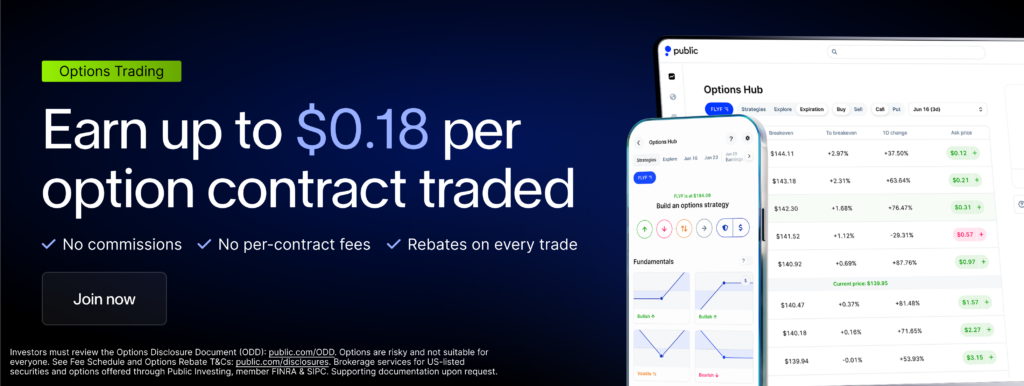Option pricing is more than just numbers on a screen; it’s a complex dance of market dynamics, time, and volatility. Ever wondered why one option might be priced higher than another, even if they seem similar? Dive deep with us into the factors that determine these prices. Equip yourself with the knowledge to navigate the options market with confidence and make informed decisions. The Options Clearing Corporations also offers a helpful document that discusses the characteristics and risks of options, which can be found on their website.
How Option Pricing Works: Factors Influencing Options Pricing

Table of Contents
Introduction
Options are specialized financial contracts that grant owners the right, but not the obligation, to buy or sell an underlying asset at a predetermined price. There are two main types of options: call options, which give the holder the right to buy, and put options, which give the holder the right to sell. For traders, it’s beneficial to understand the intricacies of how options are priced. It’s not just about knowing the cost; it’s about understanding the factors that drive that cost. In this article, we’ll delve into the key elements that influence options pricing, providing a comprehensive overview for both novice and seasoned traders.

Intrinsic Value
At its core, intrinsic value represents the immediate, tangible value of an option. It’s calculated as the difference between the current price of the underlying asset and the option’s strike price. For example, if a call option has a strike price of $100 and the underlying stock is trading at $110, the intrinsic value of the option is $10. This value is fundamental in options trading, as it provides a clear snapshot of the option’s inherent worth. However, the financial world is dynamic. If the stock price dips to $95, the intrinsic value of our call option would drop to $0 or near that mark, making it less profitable to exercise. This fluctuation showcases the importance and volatility of intrinsic value in the options market.
Extrinsic Value
Beyond the immediate profit potential represented by intrinsic value, options also carry an extrinsic value. This component captures external factors that might influence an option’s price but aren’t directly tied to the asset’s price. Key contributors include time decay (the value lost as the option nears expiration), market volatility (which can increase the option’s potential profitability), and prevailing interest rates. Imagine an option with 6 months until expiration versus one with just a week left. The longer-duration option typically has higher extrinsic value due to the uncertainty over a more extended period. Similarly, in a highly volatile market, options might command higher prices, reflecting the increased risk and potential reward. Different market conditions can either inflate or deflate this extrinsic value, making it a dynamic factor in options pricing.
What are the Factors Affecting Options Pricing?
-
The Underlying Asset’s Price
The price of the underlying asset, whether it’s a stock, commodity, or another financial instrument, is the primary driver of an option’s price. For instance, if you hold a call option for Company A with a strike price of $50, and the stock price rises to $60, the value of your option will increase because it allows you to buy the stock at $10 below the current market price.
Example: Consider stock X is trading at $150. If you own a call option with a strike price of $145, it has an intrinsic value of $5. If stock X’s price rises to $160, the intrinsic value of your option increases to $15.
-
Strike Price
The strike price is the predetermined price at which the holder of an option can buy (for call options) or sell (for put options) the underlying asset. The closer the market price of the underlying asset is to the strike price, the higher the option’s value, especially if it’s “in the money.”
Example: If stock Y is trading at $700 and you have a call option with a strike price of $690, it’s more valuable than another call option with a strike price of $720.
-
Time to Expiration
Options have expiration dates. The longer the time until an option expires, the more opportunity there is for the underlying asset to move in a favorable direction. This is where the concept of time decay comes in. As the expiration date approaches, the option loses value.
Example: Two put options on ABC stock both have a strike price of $3,200. One expires in two weeks, and the other in six months. Even if ABC’s stock is trading at $3,200 right now, the six-month option will be more expensive due to its longer duration.
-
Volatility
Volatility measures the degree to which an asset’s price fluctuates. Options on assets with high volatility tend to be priced higher due to the increased potential for returns.There are two types: implied volatility (the market’s forecast of future fluctuations) and historical volatility (past fluctuations).
Example: During a company’s earnings report season, its stock might have high implied volatility because investors are uncertain about the report’s outcome. Depending on your outlook and options position, they could either gain or lose value during this period.
-
Interest Rates
When interest rates rise, holding cash becomes more attractive. This can influence the demand for other assets, including options. Typically, as interest rates increase, call options might rise in value, while put options might decrease. The same is true in the opposite direction of the interest rates. When interest rates decrease, call options may decrease in value, while puts may increase.
Example: Consider a hypothetical situation where the Federal Reserve announces a rate hike, and you hold call options on a bank stock, those options might increase in value as higher interest rates may lead to increased bank profitability.
-
Dividends
If a stock is expected to pay a dividend, it can affect the price of options. Anticipated dividends usually decrease the price of a call option and increase the price of a put option.
Example: Stock Z announces a higher-than-expected dividend. If you hold put options, they might increase in value because the stock price typically drops by roughly the dividend amount on the ex-dividend date.
Each of these factors plays a crucial role in determining an option’s price, and understanding them can provide traders with a significant edge in the market.

Application in Trading Strategies
In the vast landscape of financial trading, understanding the nuances of options pricing can be a game-changer. By grasping the factors that influence options prices, traders can make more informed decisions, optimizing their strategies for various market conditions.
-
Hedging
With a clear comprehension of how options are priced, traders can use options as a hedging tool against potential losses in their investment portfolio. For instance, if one anticipates a decline in a stock they own, they might purchase put options to offset potential losses. The risk of this strategy lies in the loss of the premium paid for the option if it expires without value.
-
Speculation
For those with a higher risk appetite, understanding options pricing can aid in speculative trades. By predicting how certain factors will move, like volatility or interest rates, traders can buy or sell options to capitalize on these predictions.
-
Income Generation
By selling options, traders can generate additional income. This strategy often involves selling options that are out of the money, leveraging the knowledge of time decay. This strategy, however, can be risky and may have unlimited loss potential, as it exposes the seller to high liabilities if the market moves unfavorably. Market movements can be unpredictable, and it’s vital for individuals to seek professional advice and employ risk-mitigation strategies to protect their investments.
Conclusion
Options pricing, while intricate, is fundamentally influenced by a set of key factors. The underlying asset’s price, the strike price, time to expiration, volatility, interest rates, and expected dividends all play pivotal roles in determining an option’s price. By understanding and monitoring these factors, traders can navigate the options market with greater confidence and precision. As the world of finance continues to evolve, staying informed and equipped with the right tools, like our latest options offering, becomes paramount for success.
FAQs
What are the key factors that influence options pricing?
The primary factors influencing options pricing include the underlying asset’s price, strike price, time to expiration, volatility, interest rates, and expected dividends. Each plays a unique role in determining an option’s premium.
How does the price of the underlying asset affect an option's price?
The option’s price is directly correlated to its underlying asset. As the asset’s price moves, the intrinsic value of the option changes. For instance, if a stock price rises, a related call option typically increases in value. If the stock price falls, options may expire worthless.
How does volatility affect options pricing?
Volatility measures price fluctuations of the underlying asset. Higher volatility often leads to increased option premiums due to the greater potential for profit or loss. Public Premium platform provides insights into market volatility, aiding informed trading decisions.
What is 'time decay' in options, and why is it important?
Time decay refers to the reduction in an option’s value as it nears its expiration date. The closer the option is to expiration, the less time there is for the underlying asset to move favorably, decreasing the option’s extrinsic value.
How do interest rates affect options pricing?
Interest rates can influence the cost of holding an options position. Generally, as interest rates rise, call options may increase in value, while put options might decrease. When interest rates fall, call options may decrease in value, while put options may increase.
How do dividends impact options pricing?
Expected dividends can affect options prices. Anticipated dividend payouts usually decrease the price of a call option and increase the price of a put option.
What tools can help me in options trading?
Several tools can aid in options trading, from volatility indices to options calculators. Public.com offers a comprehensive platform with advanced analytics, real-time data, and educational resources, making it an important tool for both novice and seasoned options traders.